Overview
Smart phones, electric/ hybrid cars and X-Rays have undoubtedly taken an important role in today’s society. All three essential items depend on a limited resource called Rare Earth Metals. The use of Rare Earth Elements (REE) does not stop there. REEs are also used for refining crude oil, building wind turbines, making televisions and computer screens, and are necessary for production of many other important products. There is no doubt Rare Earth Metals play an important role in the world, therefore, from an investing standpoint, you might wonder who is mining these crucial metals and who is using them? This blog answers those questions by using Machine Readable Filings (MRF) and Social Market Analytics, Inc. (SMA) Complex Topic Model engine. The dataset is run across all 10-K, 10-Q, 8-K, 20-F, 6-K and 40-F filings from SEC Edgar.
Social Market Analytics, Inc. (SMA) has partnered with S&P Global Market Intelligence on ‘Machine Readable Filings’ (MRF). Machine Readable Filings is the first product to provide parsed textual data of SEC Edgar Regulatory Filings at the Total Document, Part, Item, Sub-section, and Notes level with historical baselines back to 2006. The Textual Data, Sentiment NLP, and Word Count values are provided by SMA’s patented technology. Extraneous information such as page numbers, images, and tables are removed. S&P Global and SMA also developed the same structured data values on International Company Reports.
SEC regulatory filings are formal documents reported to the U.S. Securities and Exchange Commission (SEC) that contain important information about companies such as financial statements, forward looking statements, risks associated with the company, etc. Every U.S. publicly traded company is required to submit regulatory filings to the SEC.
Companies discuss their forward focus in these documents, and you can glean a lot about a company’s direction or risks by the topics they discuss in filings. With SMA’s topic modeling capabilities you can quickly scan documents for curated topics. If you are searching for companies investing in a specific topic, this functionality makes the process much more efficient. As an example, if you want to find companies with negative exposure to Covid-19 you can search for Covid-19 mentions in the Risk Factors section of a 10-K or 10-Q. If you would like to find a company’s strategy for handling their business during Covid-19, you may want to search in the Management Discussion & Analysis section.
Machine Readable Filings (MRF) used in conjunction with SMA’s Complex Topic Model engine allows for the programmatic curation of Thematic Investing themes. Our topic modeling allows us to capture ever relevant ‘Rare Earth’ terms within SEC filings and exclude terms that are not relevant. For example, U.S. Rare Earth Minerals, Inc. mentioning their own name in a filing would not be considered relevant. SMA’s proprietary Complex Topic Model engine uses smart synonym and proximity search to make sure you capture all relevant information.
Example of the Dataset
The data is available through an API, CSV reports or other customizable options to be easily read. Below is a picture of part of the data set used for this blog. The circled context reads: “We manufacture and sell an array of plain surface prestressed steel materials and rare earth coated and zinc coated prestressed steel materials…”
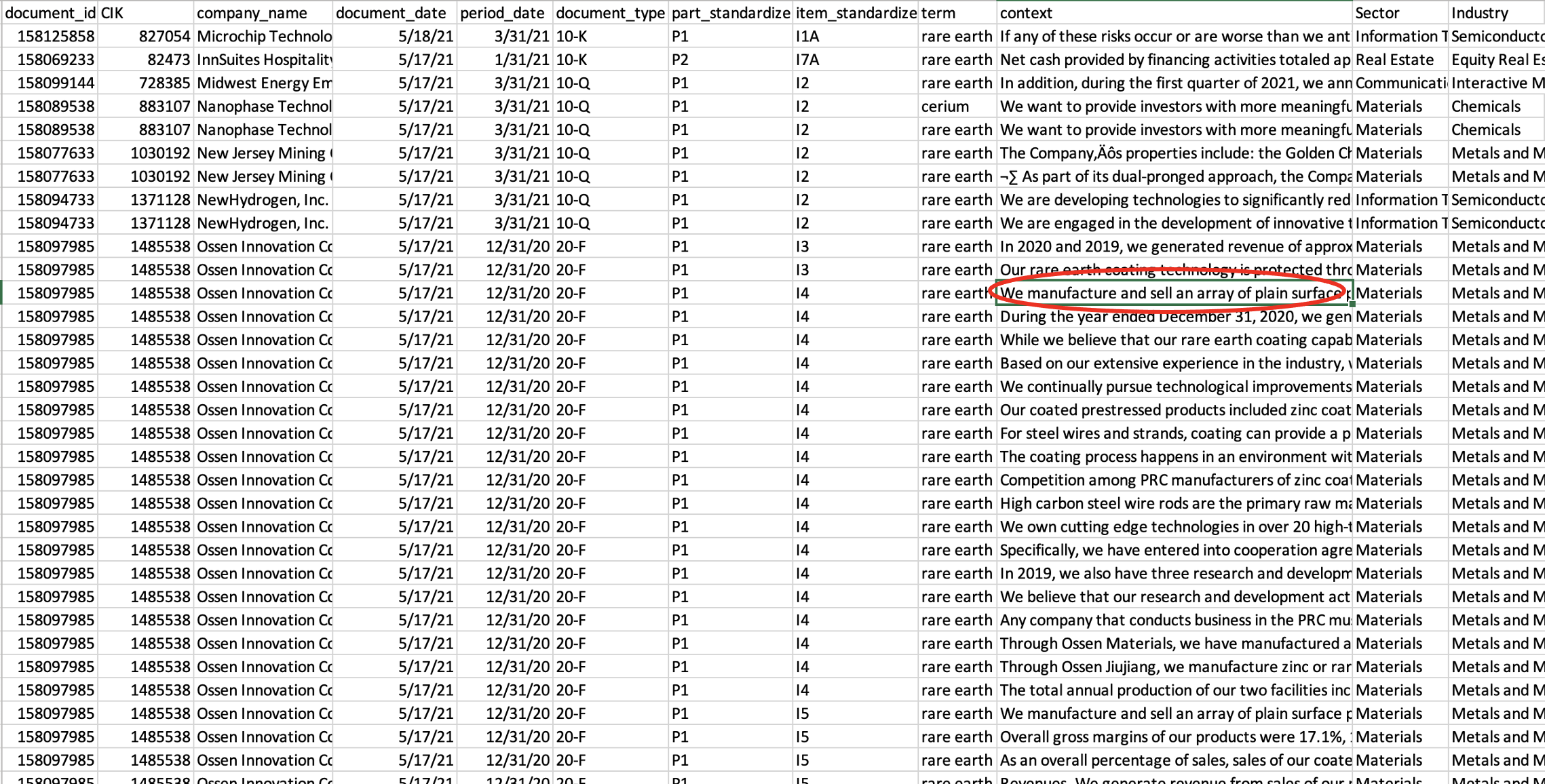
In this blog we will be illustrating the power in SMA’s topic searching by identifying companies with the most mentions of the topic ‘Rare Earth’ in their filings. The Topic Model data extraction across ~1.4 Million documents going back to 2006 only takes a few minutes. The MRF textual data structure also enables the creation of baselines.
Full Rare Earth Universe
To answer who is mining and using these Rare Earth Materials, we first must look at the topic model on a macro level. Below is a chart illustrating mentions from each sector. A hit is defined as the frequency of which a term in mentioned within an SEC filing. The topic contains model contains over 40,000 hits from January 1, 2006- May 19, 2021.
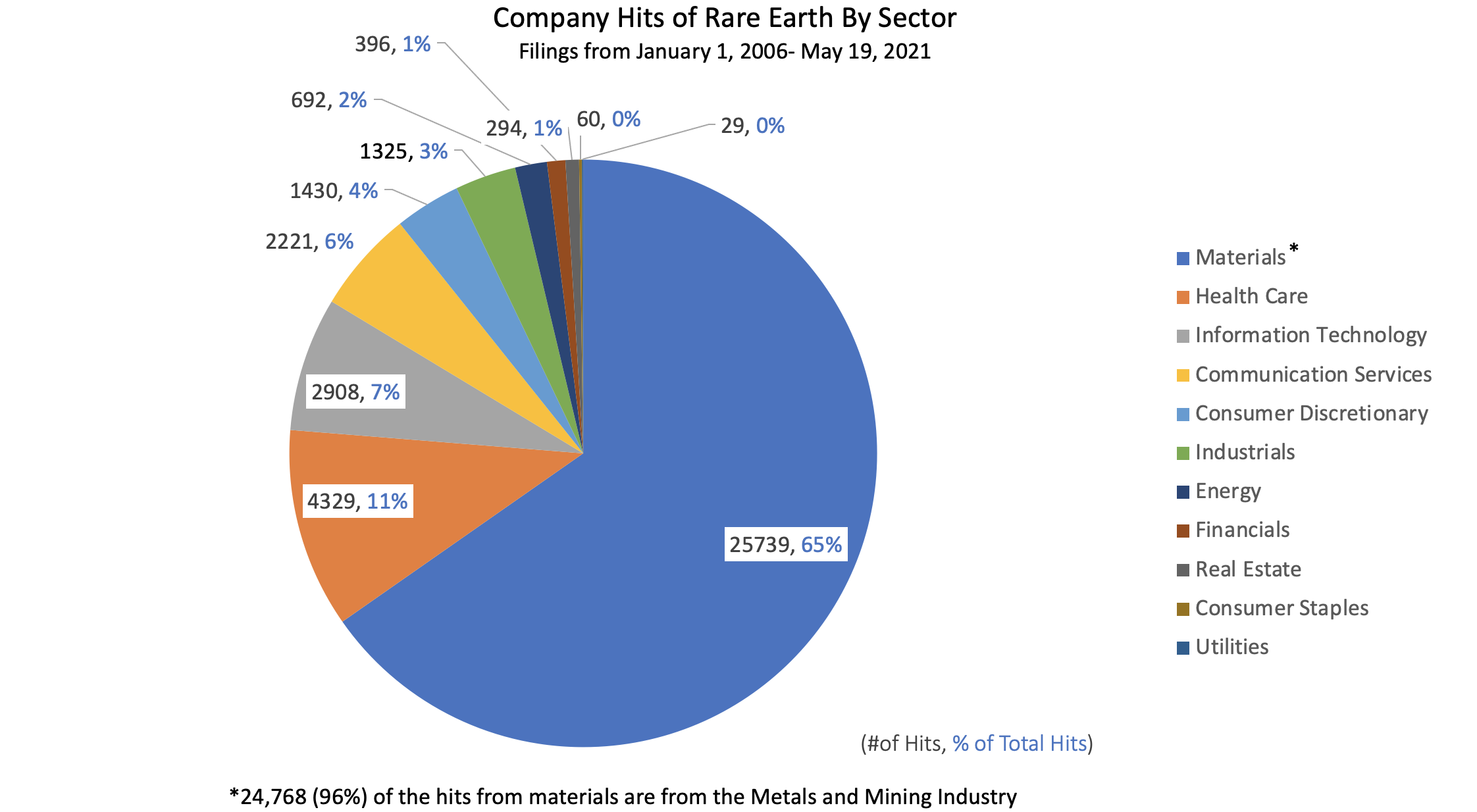
The chart demonstrates that 65% of the hits come from the Materials sector. Of the Materials Sector hits, 24,768 (96%) of the hits from materials are from the Metals and Mining Industry. Using that information, we can determine that the large majority of the Materials Sector are the suppliers. The rest of the sectors appear to be the consumers. The top two consumer sectors are Health Care (4,329 hits, 11% of total hits) and Information Technology (2,908 hits, 7% of total hits). We will look in depth at the determined largest suppliers and two largest consumers.
Materials Sector
Zooming in on the suppliers, we see that the three most mentioned Rare Earth Metals are scandium with 5,191 hits, neodymium with 1,266 hits and yttrium with 1,237. The most popular term hit by far was ‘Rare Earth’ with 11,654 hits. Knowing these are the three most talked about metals by suppliers could possibly imply that they are the three most profitable or abundant.
We know which sector the supplier is in and which metals they are discussing the most. Which specific companies are discussing these most frequently? The graph below shows the top 20 companies mentioning Rare Earth terms the most in their filings from January 1, 2006 to May 19, 2021. The bars are color coded by which metal they discuss. Scandium International, a Canadian company is the most popular and they talk about scandium an overwhelming majority of the time. It might be inferred they mention their name a lot in their filings, using by SMA’s Complex Topic Model engine we are able to exclude the mentions of “Scandium International” and only capture the relevant mentions of scandium. Scandium International is very centered on scandium and discusses the metal a lot within their filings. Molycorp (last filed in 2016), although no longer publicly traded is a close second, discusses a variety of metals. The third most popular is Texas Mineral Resources Corp which has the most mentions of any current U.S. publicly traded stock.
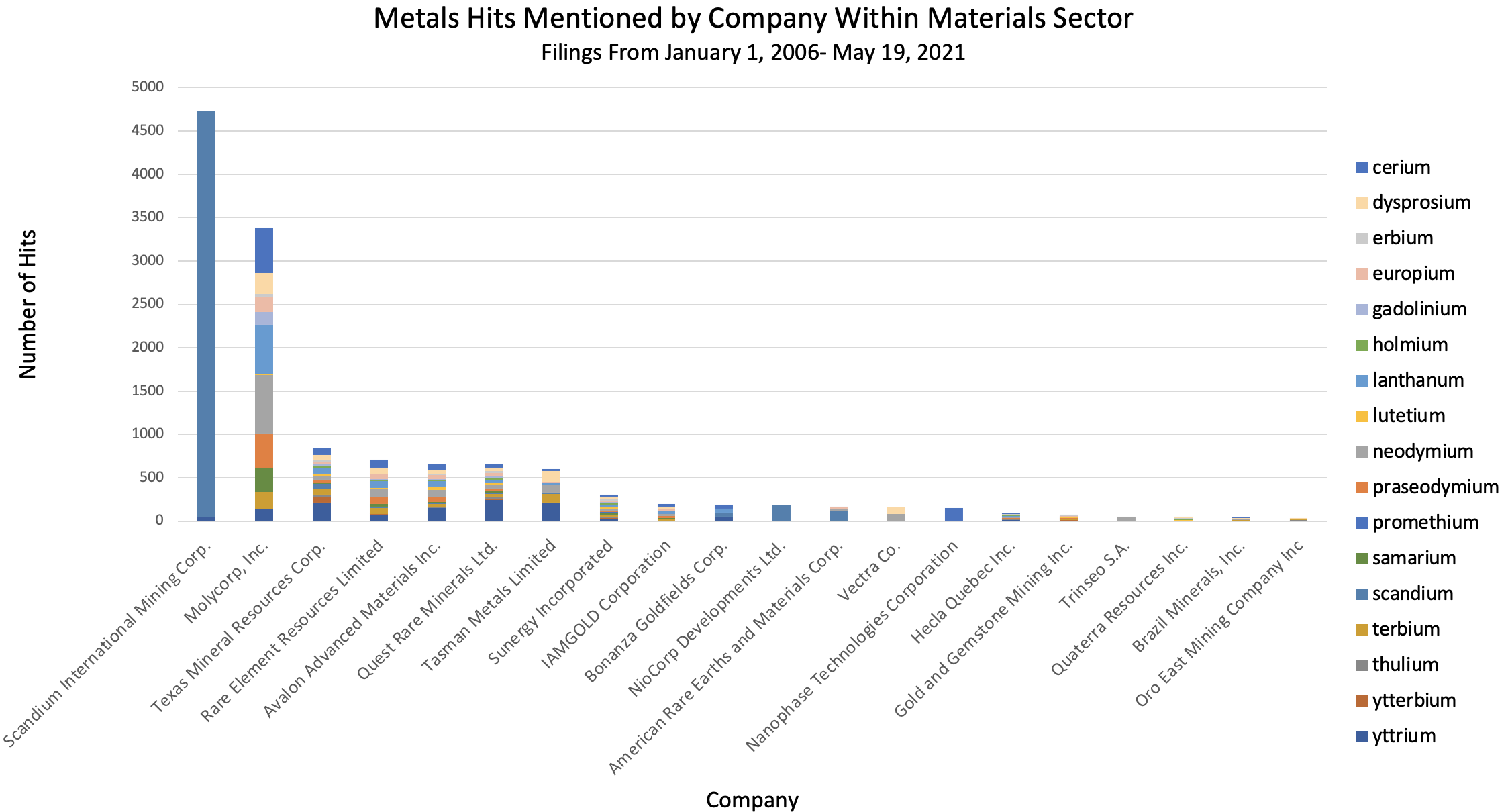
The top two suppliers of metals are a Canadian company and an American company that are no longer publicly traded. The next three companies are all trading below $5 a share. This could imply that the U.S. is not a great supplier of Rare Earth Metals. Many articles suggest that China has the majority of Rare Earth Metals. The top companies in this chart support that the majority of the supply of Rare Earth Metals are not mined by American companies.
Consuming Sectors of Rare Earth
Now that we have looked in depth into the suppliers, we will shift to the consumers. The most popularly talked about terms in these filings from January 1, 2006 to May 19, 2021 are yttrium with 800 hits, gadolinium with 708 hits and holmium with 695. There is a large drop to lutetium with 473 hits. This is vastly different from the suppliers. Scandium and neodymium are the 13th and 8th most talked metals within the consumers. Both suppliers and consumer talk about yttrium in their top three metals, however, the difference in conversation between the rest of the metals could hint at a disconnect.
After looking at the most metals, we can transition to which sectors use which metals. The graph below demonstrates which sectors discuss which metals. The Health Care sector discusses 6 of these metals more than any other sector. Their top being yttrium with 800 hits, gadolinium with 708 hits and holmium with 695 hits. These results are not surprising as yttrium is used in cancer treatments, gadolinium is used in MRI machines and holmium is used in holmium lasers, which are used in surgeries. Information technology talks about 5 different metals more than any other sector. The most popular being ytterbium with 358 hits, erbium with 339 hits and yttrium with 238 hits. These metals are all used in alloys to strengthen or soften metals.
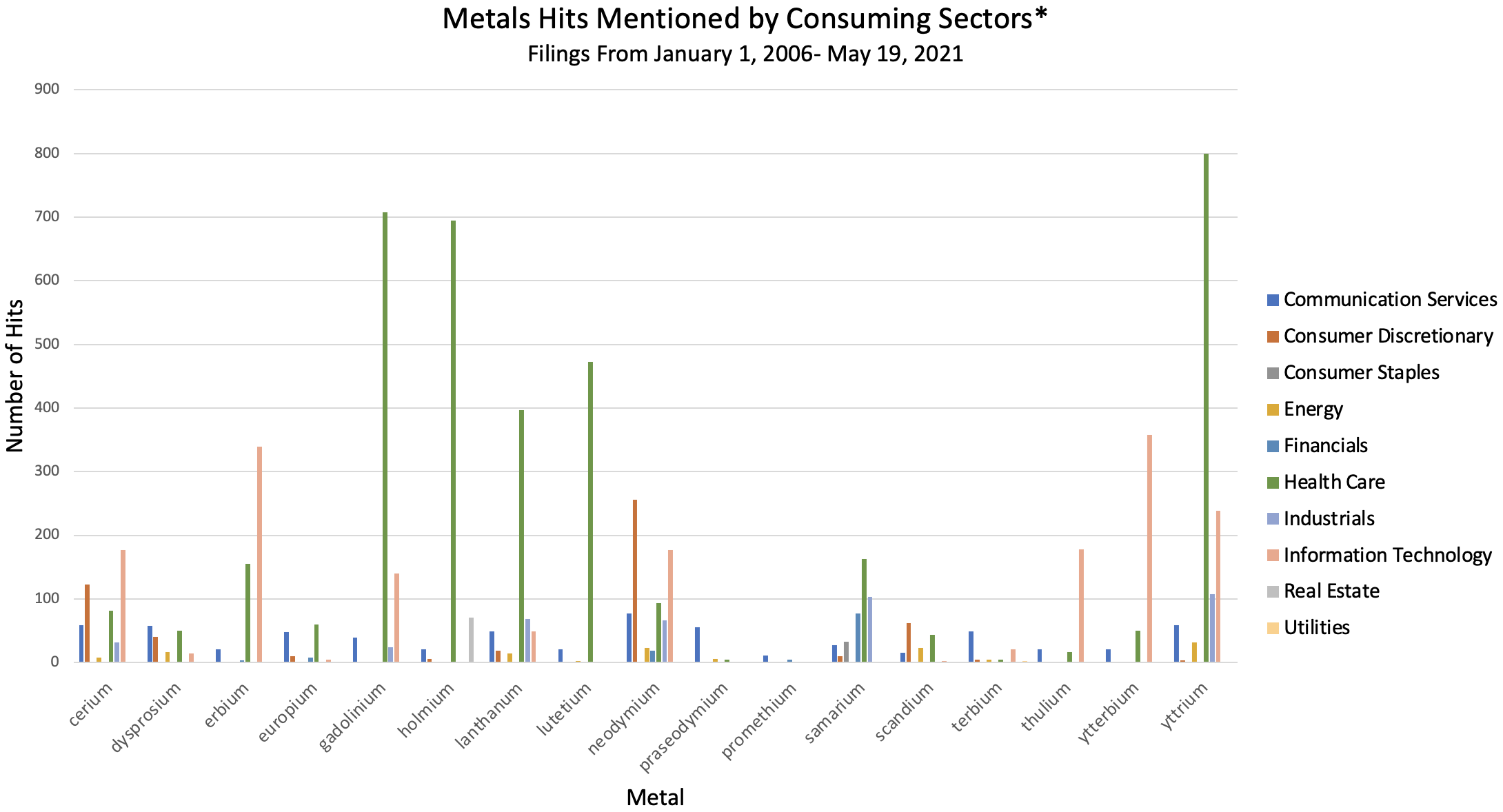
The companies with the most hits from January 1, 2006 to May 19, 2021 within the healthcare sector include Vivos Inc., Trimedyne, Inc. and Immunomedics, Inc. These companies mention yttrium and holmium the most. That could imply that these companies have large dependencies on those metals.
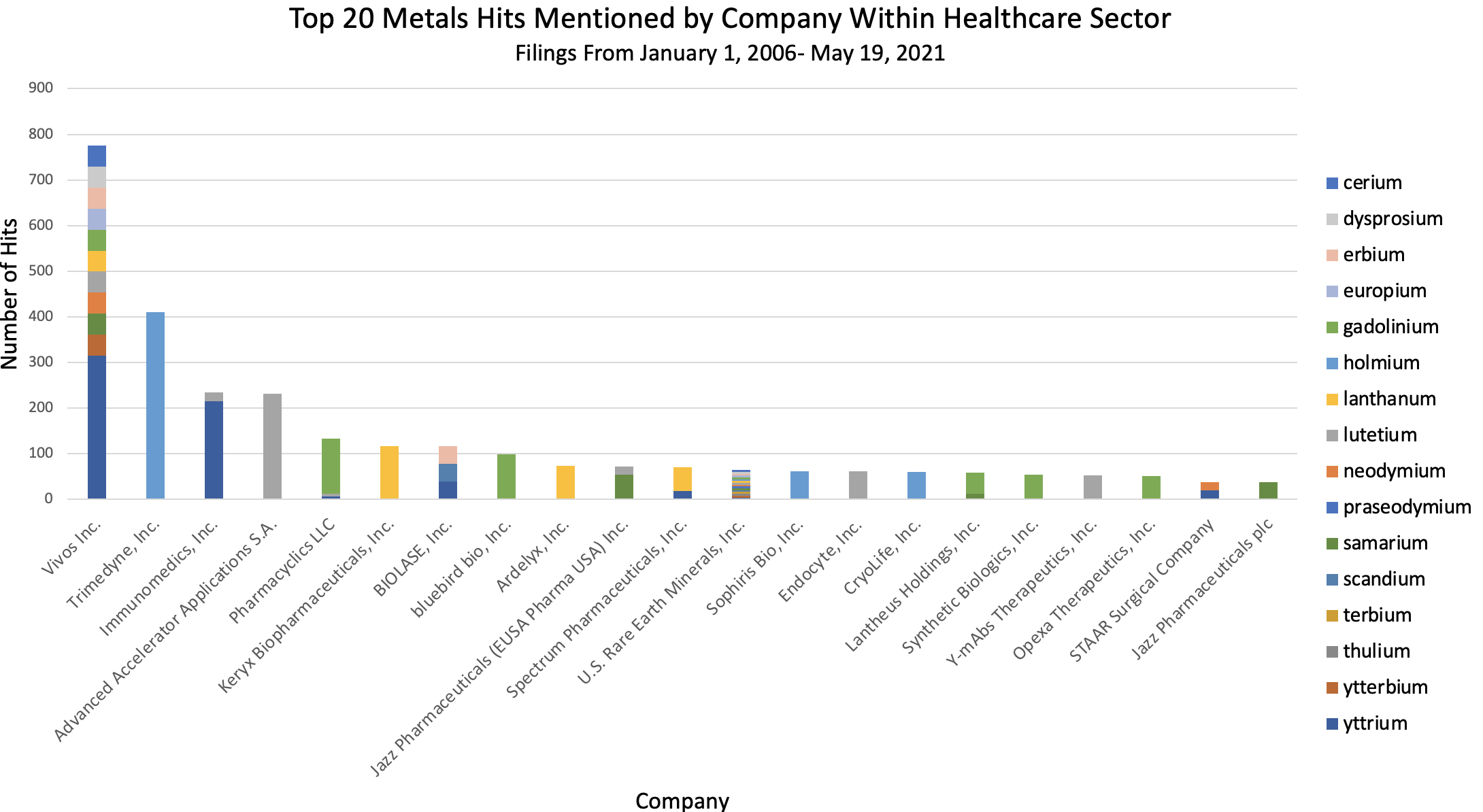
Below shows the top 20 companies within the IT Sector. The top 3 companies include IPG Photonics, Western Digital and II-VI Incorporated. IPG Photonics develops fiber lasers, Western Digital manufactures hard drives and data center equipment, and II-VI Incorporated manufactures optical materials and semi-conductors.
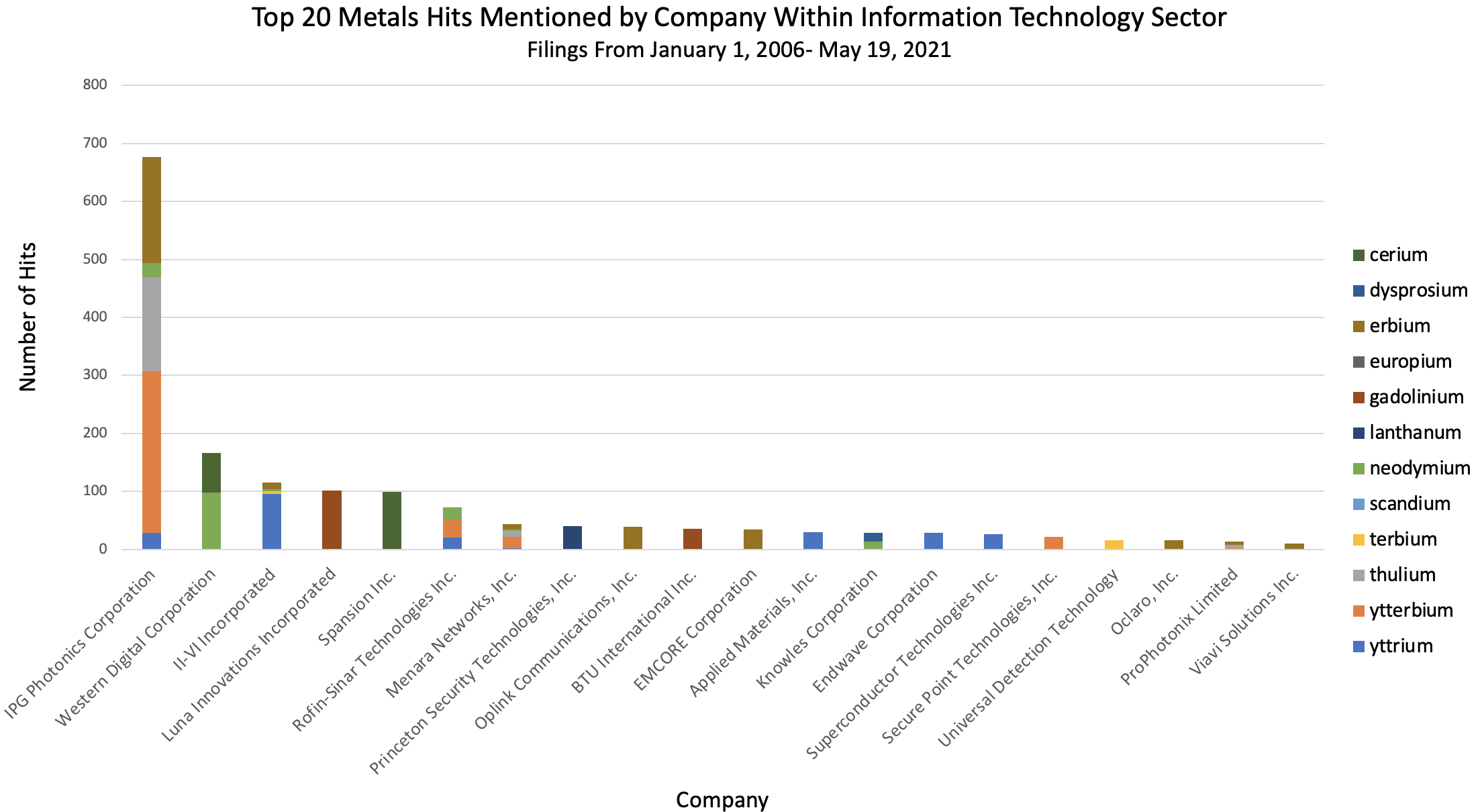
It might be surprising that large companies like Apple or Intel do not make the list for top 20 mentions of rare earth metals, considering they are used in building microchips and cell phones. That could mean that they are not dependent enough on rare earth elements to be mentioned in their Risk Factors or Business portions of their filings. In that manner it is just as important to look at which companies are not mentioning Rare Earth Metals in their filings. A shortage in Rare Earth Metals may not drastically impact their business. However, these other companies are dependent enough that a shortage and an event revolving around Rare Earth Metals could impede their business.
Conclusion
How does knowing who is and who is not mentioning Rare Earth Metals help from an investment standpoint? Investing in the suppliers could be beneficial if you believe the consumer businesses will grow. If the consumers business grows, then the demand will increase, which will allow these mining companies to sell more Rare Earth Metals at higher prices, likely increasing the value of these companies. Knowing which companies are the most and least dependent on Rare Earth Metals could give you an understanding of the risk in these companies if Rare Earth Metals become scarcer due to geo-political risk, mining accidents, civil disputes or many other reasons. Although this data gives the picture of Rare Earth from American, Canadian, and ADR SEC Filings, the data is still very powerful. SMA’s Complex Topic Model engine will soon include Global filings and Sustainability Reports.
In April 2021, SMA released in partnership with S&P Global Market Intelligence ‘Global Machine Filings’ cover +200 Countries Company Annual Reports (AR). SMA will be running a Rare Earth analysis on ARs shortly.
Today’s Macro and Technology Themes are unprecedented and cover a multitude of emerging “Themes” from Drones to ESG to Genome Research to Rare Earth, etc. The investment potential is unlimited. Thematic Investing is becoming a powerful vehicle across investments wrappers such as ETFs and Structured Products, as well as, in Portfolio holdings by Hedge Funds and Asset Management. Prior to Machine Readable Filings (MRF), capturing data within Regulatory Filings and Company Reports was difficult to impossible. The MRF data is broad across Sectors and can include Global and or U.S. listed Companies. The data can be run on any timeframe including Monthly and Quarterly for portfolio reconstitution. As you can see Social Market Analytics’ ability to read and classify documents is a powerful tool for your investment process. To learn how Social Market Analytics (SMA) can help you instantly search for Thematic Investing themes using Machine Readable Filings (MRF) SEC Edgar Filings and SMA’s Complex Topic Model engine, please ContactUs@SocialMarketAnalytics.com.



